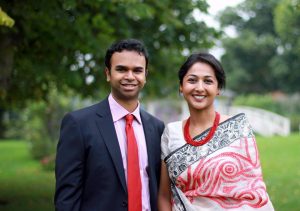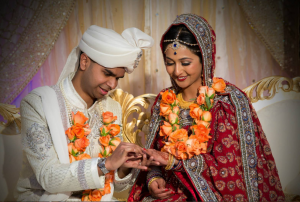The Centre for Environment Policy Equality, Diversity and Inclusion Committee interviewed Senior Finance Officer Samia Rahman from the Faculty of Natural Sciences. She gives us a window to what her Bangladeshi heritage means to her.

South Asian Heritage Month seeks to commemorate, mark and celebrate South Asian cultures, histories and communities. This month seeks to promote the understanding of the diverse heritage and cultures that continue to link the UK with South Asia, and their significant impacts on Britain’s cities, culture, art and more.
We speak to Samia Rahman, the Senior Finance Officer at the Faculty for Natural Sciences, responsible for the Centre for Environmental Policy.
Tell us a little about yourself.
I joined the Faculty relatively recently in November 2022, working to support the financial management of the Centre for Environmental Policy (CEP). Working with the CEP has been particularly welcoming as, often, when I introduce myself and talk a bit about my ethnic background, my colleagues are familiar with my country of origin: Bangladesh.
Bangladesh has been at the forefront of climate change issues as it is one of the most vulnerable countries to global warming, and therefore, not far off the CEP’s research radar. Given that sustainability and environment management have become some of the most challenging issues in recent times, I love supporting the CEP, which has been at the crux of solving these issues with its policy-focused applied research.
Aside from the Faculty of Natural Sciences, being at Imperial for the last nine years has been an amazing experience as its work culture has been inclusive of all backgrounds. With an emphasis on work-life balance, it is one of the reasons why I continue staying at Imperial.
What does your heritage or ethnicity mean to you?
Bengalis are predominantly spread between two countries: India and Bangladesh. While Bengalis in India are known as West Bengalis, Bengalis from Bangladesh are known as Bangladeshis. Our culture is very similar in many ways, and what binds us the most is our love of food and a good adda (conversation)!
We like to eat fish, and have steamed sweet dumplings called ‘pitha’ (made from jaggary and rice flour). A fair share of our food have contributed to the modern-day Indian cuisine, including Roshogolla (white cheese balls in sugar syrup).
As a British-born Bangladeshi, it is no surprise that I have struggled with my identity growing up. People around me at the time, whether it was teachers or classmates in primary school, were of the impression that Bangladesh is a country where illiteracy rates were high and poverty was rife. To a certain extent, the stereotype was true, but it also reduced the Bengali identity to that of a repressed nation. Being a Muslim and female didn’t help me either whereby ticking all three minority boxes meant that, on paper, I was from a disadvantaged background. In fact, my cultural background was just as diverse as any other culture.

A lot of my misconception around what it meant to be Bangladeshi was broken when I went to live in Bangladesh. My family relocated to Bangladesh during my formative years due to my grandmother being unwell. When I first went in 1995, I really missed London. The culture shock seeped in slowly as we realised that we would not be getting the silky-textured chocolates from the UK and would be limited when conversing fluently in English, which was more of a native tongue for me than Bengali.
Over time, I came to appreciate my heritage when I started going to an English Medium School in Dhaka. Peers spoke to me in English, so I had the best of both worlds as I was welcomed into an environment that was rich with warm and hospitable native Bangladeshis.
Living in Dhaka was an eye-opening experience. The community recycled pretty much anything and everything. For example, wood shavings from carpentry were charred and transformed into tooth powder. There was very little waste and sustainable living was at the core of our living.
Being a relatively poor country, we were acutely aware of being as sustainable as possible. In some ways, my culture taught me to re-use and re-purpose. Bangladesh was one of the early adopters of banning plastic bags and had historically used bags made from jute.
Connecting to my roots made me discover a whole new world in terms of my identity. Ethnicity has become more than a skin colour. It is a way of life that has slowly evolved but, at its core, remains fundamental to my way of life as this is a link that I can use to connect with my ancestors.
From poetry to kantha stitch embroidery, being a Bangladeshi is nothing short of a having vibrant identity. It would be a mistake to say that being Bangladeshi represents a single way of life. There are Bangladeshi people from all walks of life, who have migrated to different parts of the world and assimilated elements of their host country cultures. If a generalisation were to be made about my ethnicity, it would be that we are generally very friendly.
How do you celebrate your heritage?
The religious demographic of Bangladeshis is primarily comprised of Hindus and Muslims, with Christianity and Buddhism being a subset minority. As a Bangladeshi Muslim, I celebrate Eid Ul-Adha and Eid Ul-Fitr, where we wear brand new clothes – usually our traditional female attire, such as a saree or shalwar kameez, while men wear a punjabi (also known as a kurta in the Indian subcontinent).
We visit the mosque in the morning after performing ablution. After prayers, we would normally eat sweet desserts and greet fellow Muslims celebrating with “Eid Mubarak”. Both Eids are a day of feasting, and definitely not ones for counting calories!

Like the Punjabi community, who celebrate the beginning of the harvesting season with Vaisakhi, when Bengalis and Bangladeshis celebrate Pohela Boishakh. Women wear red and white sarees, while men dress in punjabis. While the tradition is to eat fermented rice (which becomes alcoholic) with fried fish, I abstain as my palette is not quite so refined.
My family and I also partake in the festival of Durga Puja (a homage to the Hindu goddess Durga) as I have many Bengali Hindu friends. I love being a part of this festival as I feel, along with the wider Bengali community, that the goddess Durga symbolises the ultimate feminist in her fight against evil.
How could society or your colleagues improve inclusivity of your heritage?
Bangladesh was a relatively unknown country when I was growing up. It gained independence in 1971 but our culture has been embedded with India and, subsequently, East Pakistan. Apart from our food, which was historically labelled as Indian cuisine (as were 95 per cent of Bangladeshi restaurants in the UK), we have come a long way to carving out a space for our own identity.
We are an ethnicity in our own right. Being a part of the Indian subcontinent does not imply that we are a homogenised society. Rather, we have traits that distinguish us from other countries within the subcontinent. It is a mistake to generalise our shared customs as we have subtle nuances that make us distinct.
Thanks to the internet and globalisation, there is a growing awareness of my heritage. Having the opportunity to reach out to a diverse community in the UK and at Imperial has meant that, naturally, colleagues and society at large are curious about my customs, and it is welcoming to be able to give them a glimpse into my world.